Standard Pro Tour Qualifier season is over, and for some (like me) that signals a time to rejoice. I hadn’t experienced any joy or success playing the Standard format, which left me with feelings of mediocrity and just a general lackluster feeling. I’m excited to put that behind me and dive into an entirely different kind of format. I would love to play in the next Pro Tour and have a few chances between Grand Prix Philadelphia this coming weekend and local PTQs in the following weeks should I fall short in Philly, so I’m hopeful.
First I’d like to talk about the format a little, and then we’ll do some sealed pool exercises.
Evasion Is Important
This may seem obvious to seasoned Sealed Deck veterans or even just experienced Limited players. However, evasion is at a premium in this format because instead of occasionally being able to build your own Baneslayer Angel, you can do it pretty much every game. “Voltroning” is encouraged, and simply putting a Hopeful Eidolon or a Nimbus Naiad (two premium commons, but commons nonetheless) on a reasonable creature is going to create an immense threat that will demand perhaps even multiple spells to deal with.
This is probably the thing I like the least about the format. There are a finite number of ways to answer an enhanced creature, and as such things can easily spiral out of control. It’s worth noting that once something has spiraled out of control, it’s very difficult to simply not lose immediately. This brings us to our next point.
Bounce Is Amazing
When the norm is to play a creature and then enchant it, any spell that is bounce or similar is going to overperform. A card like Voyage’s End is going to save you from the tears and grief that a turn 1 Favored Hoplite with an Ordeal might otherwise bring you. As the game progresses, a timely Griptide is going to lock things up, and Sea God’s Revenge can range from a stabilizing measure to a simply unbeatable card. Retraction Helix is a great addition to the stable of premium blue instants since it does double duty, enhancing one of your own creatures (a heroic enabler!) while removing one of theirs. Of course, it does require your creature to be untapped and not summoning sick, but alas for one mana you can’t do much better.
Blocking Is Difficult & Life Gain Is Important
These are tied together. Due to the sheer quantity of ways combat can go wrong, blocking is just very difficult. The same really goes for when you’re attacking into open mana. If they have a creature, chances are they have one of these spells to mess up your plans:
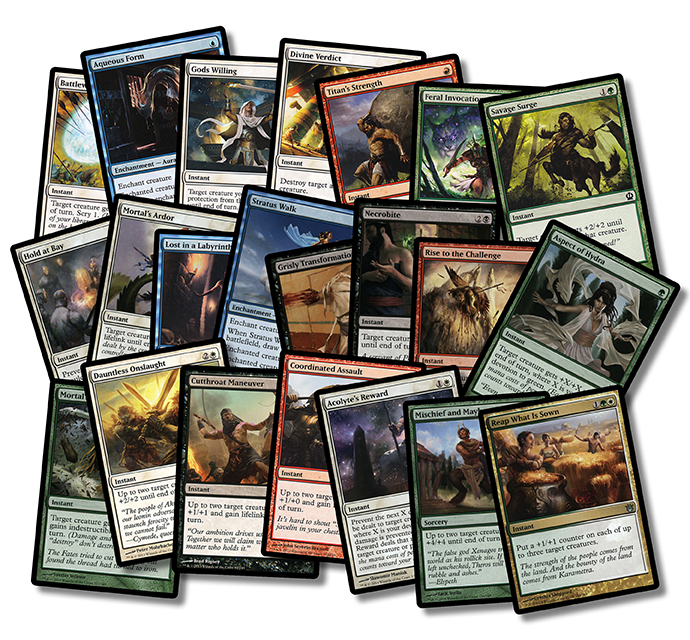
In addition, Lash of the Whip, Bile Blight, and Eye Gouge can be used as combat tricks. Glimpse the Sun God and Sudden Storm will likely keep you from blocking in the first place—at least you’ll know you can’t block!
This doesn’t take into account on-board things like a Deepwater Hypnotist untapping and making your 2/2 into effectively a 0/2 and unable to block or the deathtouch from a Bow of Nylea or even the looming threat of Phalanx Leader. Sometimes if you’re planning to block, they’ll just have a Leafcrown Dryad or a Hopeful Eidolon to bestow, turning your opportunity to trade into a simple chump blocking situation.
In the late game, there are even more bestow creatures to worry about. Simply put, you’ll wish you had attacked (if you could have) in many of these spots. If you can’t block, you’ll need to “race,” and if you are trying to race, the best way to win the race is with lifelink. But barring lifelink there are a few incidental life gainers whose stock has risen tremendously in this format. A card like Time to Feed would be great in any format, but the fact that it can nullify a three-power attacker next turn or a few turns down the line turns it into an all-star beyond the simple point of it being removal. Nylea’s Disciple can be similarly backbreaking, and an unblockable Oreskos Sun-Guide (should that somehow happen) can be more frustrating than playing against Stormbreath Dragon!
Removal Is Not Particularly Strong
There are of course good removal spells like Magma Jet, Lightning Strike, and a few others. However, Asphyxiate is what passes for good in this set since it can hit almost anything the turn it comes out. There are indeed a lot of “bad” removal spells. Sip of Hemlock really can kill anything, but it costs a whopping six mana. Lash of the Whip is okay since it’s an instant, but Rage of Purphoros is incredibly unexciting. Excoriate is slow and narrow, but even that is something I’ve often welcomed into my deck. Indeed, it is bounce that has been pushed in this format and removal that is lacking.
Of course, they really did need to do this to make the bestow mechanic work. If every removal spell was “B, instant, destroy target creature and all enchantments on it, this cannot be countered, this is colorless,” the format would be bad in a different way. Not having access to good removal is a somewhat interesting restriction that I feel they went too far with (particularly when it comes to uncommons). On a slight tangent, in my opinion when your opponent is casting Phalanx Leader and you’re literally about ready to concede, I think something is wrong. The same goes for the opening of Favored Hoplite into an Ordeal. There needs to be slightly more answers to these openings given how common they are.
Splashing Isn’t That Easy
This isn’t a multicolor block or even a multicolor set, so being able to splash easily isn’t a given. In addition to the rare lands (Temples), there’s Traveler’s Amulet, Opaline Unicorn, and not much else outside of green. That being said, it isn’t impossible to splash your best card in a shared color (something like a Polis Crusher or a Horizon Chimera is easy to do sometimes, or even something like a Sentry of the Underworld if you’re in U/W and get the appropriate Temples.)
When times are tough, you have to splash, and if your pool is underpowered, I recommend greed over consistency in an effort to compete with better decks. But for the most part if your deck is actually good, I’d err on the side of consistency to be able to cast your good spells on time, and I’m sure that’s very intuitive. A good deck isn’t that good if it can’t cast its spells, and a bad deck isn’t that good even when it can cast its spells, so you really do need to be able to evaluate how good your deck is.
We’ve talked about the format enough now that I’d like to actually build some sealed pools with you. We have this Sealed Deckbuilding widget, which is pretty easy to use. There are the three buttons that will help you quickly sort the pool (easier than both Magic Online and real life basically). Then if you want, you can click a card and then click either Junk or Deck. You can also move more than one card at a time. A good method that I might suggest is to move all of some color to your deck and then cut the unplayables into junk and continue through the colors/pairs/combinations to see how you should actually build your deck. This is similar to a method I might employ in real life, and it’s one that’s worked for me in the past.
Finally, a couple of notes. Sometimes your deck will look great and end up missing something important. In Grand Prix Sacramento I thought my deck was great, but it was missing a few key pieces of removal/bounce/something, so in the last round I lost to a Hundred-Handed One that I couldn’t remove once it went monstrous (or beforehand for that matter.) I had boarded in an Aqueous Form after seeing the Hundred-Handed One in game 2, but I ran out of chump blockers before I could win. Sometimes your bad decks will play well, and sometimes a mana curve with strong creatures and removal is enough. At a Sealed Deck tournament, it’s important to focus on playing your match and not worry about how bad or good your deck is.
Another thing that happens to a lot of people is that they build a Sealed deck that looks like a good Draft deck and then end up getting ground out by a slower deck full of removal and card advantage. You run into the slower decks a lot more often in Sealed because decks are more unfocused; since you weren’t drafting, you might not end up with a hyperfocused “machine” of a deck. It’s important to just play your deck and focus on what you can control.
As for the pools below, I didn’t cherry pick them. These pools aren’t by any means necessarily good or bad. They do all share one thing that is great for our purposes, but they are just the pools I happened to open when I was practicing. None of these pools contain a mythic rare. The good mythics are really what you want to open in Sealed because they’re absurdly powerful, but when you open an Elspeth, Sun’s Champion, you can’t even consider not playing it under most circumstances, which really makes building a lot less interesting (which color do I pair with my Elspeth?). Decisions like that are interesting, but honestly the following pools are much more interesting.
Pool 1
- 1 Oracle of Bones
- 1 Nyxborn Rollicker
- 1 Felhide Spiritbinder
- 1 Excoriate
- 1 Oreskos Sun Guide
- 1 Akroan Skyguard
- 1 Favored Hoplite
- 1 Nyxborn Shieldmate
- 1 Pinnacle of Rage
- 1 Leonin Snarecaster
- 1 Everflame Eidolon
- 1 Vanguard of Brimaz
- 1 Hundred-Handed One
- 1 Titan’s Strength
- 1 Gods Willing
- 1 Revoke Existence
- 1 Ghostblade Eidolon
- 1 Dauntless Onslaught
- 1 Labyrinth Champion
- 1 Bolt of Keranos
- 1 Rise to the Challenge
- 1 Battlewise Valor
- 1 Lightning Strike
- 1 Elite Skirmisher
- 1 Grisly Transformation
- 1 Eye Gouge
- 1 Marshmist Titan
- 1 Forsaken Drifters
- 1 Nyxborn Eidolon
- 2 Divination
- 1 Nimbus Naiad
- 1 Retraction Helix
- 2 Nyxborn Triton
- 1 God-Favored General
- 1 Battlewise Hoplite
- 1 Mortal’s Resolve
- 1 Mortal’s Ardor
- 1 Nessian Courser
- 1 Stratus Walk
- 1 Plea for Guidance
- 1 Time to Feed
- 1 Pillar of War
- 1 Dark Betrayal
- 1 Reckless Reveler
- 1 Agent of the Fates
- 1 Pheres-Band Raiders
- 1 Wavecrash Triton
- 1 March of the Returned
- 1 Akroan Crusader
- 1 Griptide
- 1 Keepsake Gorgon
- 1 Dissolve
- 1 Claim of Erebos
- 1 Coastline Chimera
- 1 Asphodel Wanderer
- 1 Horizon Scholar
- 1 Nessian Asp
- 1 Karametra’s Favor
- 1 Archetype of Imagination
- 1 Defend the Hearth
- 1 Flamecast Wheel
- 1 Snake of the Golden Grove
- 1 Borderland Minotaur
- 1 Traveler’s Amulet
- 1 Warchanter of Mogis
- 1 Pharika’s Cure
- 1 Swordwise Centaur
- 1 Shredding Winds
- 1 Opaline Unicorn
- 1 Thassa’s Emissary
- 1 Siren Song Lyre
- 1 Feral Invocation
- 1 Silent Artisan
- 1 Satyr Hedonist
- 1 Satyr Rambler
- 1 Epiphany Storm
- 1 Breaching Hippocamp
- 1 Returned Phalanx
- 1 Hold at Bay
- 1 Mnemonic Wall
- 2 Viper’s Kiss
If you sort this pool by color to start (as you would in real life), you’ll quickly notice that only black is easily dismissed. It has Agent of the Fates and Pharika’s Cure as well as Keepsake Gorgon, but beyond those three excellent cards (Agent and Gorgon are among the best in the set, so it’s quite unlucky not to be able to play them given that you have them) there are almost no good cards. Returned Phalanx is nice, but it forces you into U/B. Nyxborn Eidolon is great once you’re already willing to be black, but there’s simply nothing pulling me into black other than three aforementioned cards.
If we do venture into black, we will quickly run out of playables, and that’s the problem. I don’t want to go into too much depth evaluating cards, but I don’t want to have a deck full of Warchanter of Mogis and Marshmist Titans unless I have multiple Gray Merchant of Asphodel and Disciple of Phenax and just generally a much higher quality of black cards than are present here.
Green is similarly short on playables, but it only has a Nessian Asp to catch our attention. Swordwise Centaur is great but hard to cast, Time to Feed is very good, and Nessian Courser is nice, but that’s it. We don’t even have gold cards to tempt us into splashing, so green is out.
This leaves us just three colors. I think white is the deepest of the three remaining colors, as not only does it have Dauntless Onslaught but it also has Akroan Skyguard, Favored Hoplite and Hundred-Handed One. It has a slew of creatures that we’re actually happy to play (granted, they are small). I think this has the makings of a base color. Immediately we should be drawn to Battlewise Hoplite once we determine that we are white given that Battlewise Hoplite is great and our blue is in contention to be played. White gives us twelve to fourteen cards depending on how we’re feeling. I don’t know if we want to play God-Favored General given that we don’t have a Springleaf Drum since it’s hard to get through and is bad when it doesn’t make creatures. Mortal’s Ardor is borderline as well.
Blue offers us about thirteen nice cards, including the Hoplite. But two of them are Divination, and two of them are six-drops. I am not anti Divination, but I don’t think every deck necessarily wants it. There is a real cost to taking a turn off from casting your creatures to play it, especially if the rest of your cards are creatures. There is a similar cost to including six-drops in your deck. It means you need more lands; if you were tempted to play sixteen, you might have to risk getting flooded and play the full seventeen to incorporate the cards.
Now let’s look at red. If you were building this in real life, you probably would have been drawn to red for the rares. Felhide Spellbinder is a great creature that is costed aggressively given its size and has both a fun and good ability. Labyrinth Champion is a slightly overrated rare creature, but it makes heroic triggers very valuable and is a card I’d welcome into just about any Sealed deck.
Finally, we have Oracle of Bones, which I think is at home in a deck with black so that you can threaten Sip of Hemlock. In this deck we can play our Pinnacle of Rage as something to do with the trigger. Also, sometimes, when I play with or against Oracle of Bones, the person making the choice might just be too scared to let it come into play on the smaller side. A free Sip, Rage, Lash, or Pinnacle can be game over.
In addition, we have Lighting Strike and Bolt of Keranos as premium removal spells and Everflame Eidolon as a fantastic bestow creature. The fact that the red cards are more aggressive really drew me to red because I do think the white creatures want to be paired in an aggressive fashion, but my personal biases here might have cost me since in the end I didn’t succeed with the W/R deck. I welcome you to comment on if you think the blue is “too good” not to play with the white.
The next step for me was to eliminate the unplayables from the colors I was interested in (red and white), which brought me here:
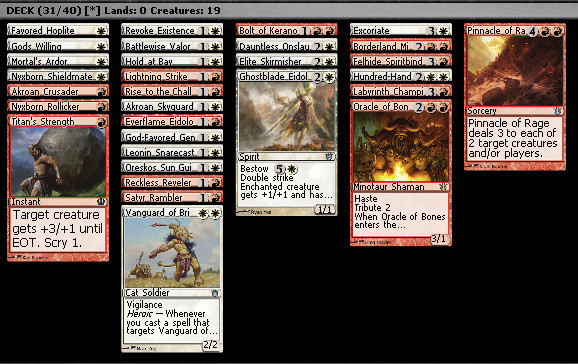
Of course, this is using the loosest definition of the term playable. So this leaves us with 31 cards, or in other words seven or eight cuts to make depending on how our mana works out.
The cards I decided to cut were Mortal’s Ardor, Akroan Crusader, Hold at Bay, God-Favored General, Reckless Reveler, Satyr Rambler, Borderland Minotaur, and Oracle of Bones.
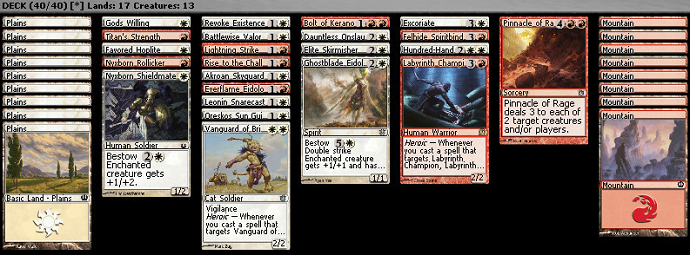
Despite speaking about the upside of Oracle of Bones, I chose not to include it here due to its RR casting cost. I didn’t want to play eight Plains and eight Mountains, and other than the Pinnacle, I could probably only get a free Excoriate if things worked out. Otherwise Bolt and Strike are the only real options, which are not terribly great. If I was going to play more Mountains in my deck, I would have probably played the card anyway because the threat is very real and must be respected as I alluded to earlier.
I may have also overestimated the quality of the deck initially, and indeed those who I showed it to liked it very much. This made me slightly overeager to play an extra land to ensure I didn’t lose that way. The other cuts are probably pretty self-explanatory, and as I said before, I’ve played all of those cards and will play them again when the time is right. But I had more than enough cheap creatures and heroic enablers, so I didn’t need to stretch for any of them.
Pool 2
- 1 Nyxborn Rollicker
- 1 Forgestoker Dragon
- 1 Divine Verdict
- 1 Excoriate
- 1 Oreskos Sun Guide
- 1 Fleecemane Lion
- 1 Akroan Skyguard
- 1 Loyal Pegasus
- 1 Lagonna-Band Elder
- 1 Coordinated Assault
- 1 Magma Jet
- 1 Polis Crusher
- 1 Revoke Existence
- 1 Ghostblade Eidolon
- 1 Nessian Asp
- 1 Dragon Mantle
- 1 Traveler’s Amulet
- 1 Wingsteed Rider
- 2 Akroan Phalanx
- 1 Spearpoint Oread
- 1 Minotaur Skullcleaver
- 1 Lightning Strike
- 1 Lash of the Whip
- 1 Wild Celebrants
- 1 Fate Foretold
- 1 Blood-Toll Harpy
- 1 Astral Cornucopia
- 1 Baleful Eidolon
- 2 Shredding Winds
- 1 Annul
- 1 Nullify
- 1 Stratus Walk
- 1 Retraction Helix
- 1 Siren of the Silent Song
- 1 Setessan Griffin
- 1 Karametra’s Favor
- 1 Setessan Starbreaker
- 1 Yoked Ox
- 1 Culling Mark
- 1 Divination
- 1 Nessian Courser
- 1 Skyreaping
- 1 Lightning Volley
- 1 Graverobber Spider
- 1 Nyxborn Triton
- 1 Rescue from the Underworld
- 1 Scouring Sands
- 1 Gift of Immortality
- 1 Kragma Warcaller
- 1 Pharagax Giant
- 1 Karametra’s Acolyte
- 1 Thassa’s Rebuff
- 1 Dark Betrayal
- 1 Claim of Erebos
- 1 Grisly Transformation
- 1 Whelming Wave
- 2 Forsaken Drifters
- 1 Servant of Tymaret
- 1 Feral Invocation
- 1 Mortal’s Resolve
- 1 Aqueous Form
- 1 Borderland Minotaur
- 1 Pheres-Band Tromper
- 1 Warchanter of Mogis
- 1 Nyxborn Wolf
- 1 Savage Surge
- 1 Satyr Wayfinder
- 1 Vulpine Goliath
- 1 Spellheart Chimera
- 1 Decorated Griffin
- 1 Sunbond
- 1 Satyr Piper
- 1 Thassa’s Bounty
- 1 Fearsome Temper
- 1 Great Hart
- 1 Breaching Hippocamp
- 2 Impetuous Sunchaser
- 1 Pheres-Band Centaurs
- 1 Priest of Iroas
- 1 Viper’s Kiss
Again, a color sort will quickly eliminate blue and black from the running, as there’s really nothing there. It gets harder after that though. Two of our good rares are G/x but not the same x, and to top that off our green is kind of weak with Nessian Asp and just about nothing else.
In addition to the utterly mediocre green, we’re a little short on a straight R/W deck. I think we can get to 22 cards if we play all the garbage you hope not to have to play, and eighteen lands and a bunch of bad cards is not a recipe for victory. This is indeed a pool where I decided to splash, and I do think it was right. It increased the quality of my deck pretty significantly, allowing me to cut Borderland Minotaur, Pharagax Giant and the Sunchasers. I also had the Amulet, which helped out.
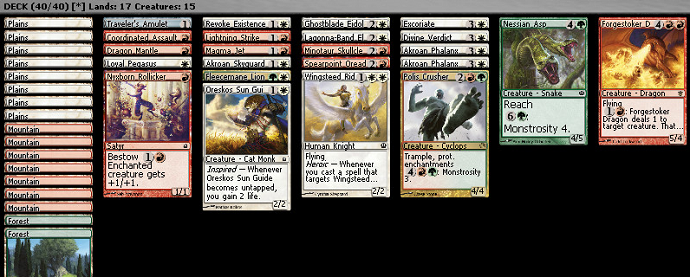
While I am not detailing all the decisions I made to arrive at this point, I was happy with the realization to play the third color and the extra mana source. In one round I sideboarded in two Shredding Winds, which were definitely not on my opponent’s radar. In general as I illustrated above and have spoken about ad nauseam before (in the context of Standard), if your curve is very important to you then missing a color will be devastating, as a quick aggressive curve just doesn’t work if you miss a color, miss your two-drop, or whatever other misfortune can befall you.
Playing three colors basically allowed me to play all of my good cards, including all the good removal, the Wingsteed Rider, the rares, and the Asp. It also enabled me to maximize Akroan Phalanx, which I have so far not played without Mountains but am not necessarily above it. Phalanx is great with red mana though, allowing you to trade your early drops drawn in the midgame for their bigger guys when you can.
Pool 3
- 1 Cavalry Pegasus
- 2 Divine Verdict
- 1 Hero of Iroas
- 1 Oreskos Sun Guide
- 1 Akroan Skyguard
- 1 Favored Hoplite
- 2 Nyxborn Shieldmate
- 1 Time to Feed
- 1 Nylea’s Emissary
- 1 Revoke Existence
- 1 Karametra’s Favor
- 1 Ordeal of Heliod
- 1 Courser of Kruphix
- 1 Pheres-Band Tromper
- 2 Nyxborn Wolf
- 1 Swordwise Centaur
- 1 Vulpine Goliath
- 1 Glimpse the Sun God
- 1 Archetype of Courage
- 2 Voyaging Satyr
- 1 Gray Merchant of Asphodel
- 1 Loathsome Catoblepas
- 1 Forsaken Drifters
- 2 Baleful Eidolon
- 2 Voyage’s End
- 1 Pheres-Band Centaurs
- 1 Annul
- 2 Benthic Giant
- 1 Vaporkin
- 1 Omenspeaker
- 1 Evanescent Intellect
- 1 Wild Celebrants
- 1 Whip of Erebos
- 2 Nyxborn Triton
- 1 Battlewise Hoplite
- 2 Yoked Ox
- 3 Nessian Demolok
- 1 Thunder Brute
- 1 Charging Badger
- 1 Titan of Eternal Fire
- 1 Prowler’s Helm
- 1 Aspect of Hydra
- 1 Firedrinker Satyr
- 1 Titan’s Strength
- 1 Psychic Intrusion
- 1 Akroan Crusader
- 1 Coordinated Assault
- 1 Keepsake Gorgon
- 2 Warchanter of Mogis
- 1 Tormented Hero
- 1 Perplexing Chimera
- 1 Marshmist Titan
- 1 Asphodel Wanderer
- 1 Ephara’s Enlightenment
- 1 Mortal’s Resolve
- 1 Siren of the Silent Song
- 1 Divination
- 1 Stratus Walk
- 1 Revoke Existence
- 1 Felhide Minotaur
- 1 Sphinx’s Disciple
- 1 Fall of the Hammer
- 1 Spellheart Chimera
- 1 Scouring Sands
- 1 Scholar of Athreos
- 1 Epiphany Storm
- 1 Boon of Erebos
- 1 Archetype of Aggression
- 1 Spearpoint Oread
- 1 Hold at Bay
- 1 Asphyxiate
- 1 Claim of Erebos
I’ve had all kinds of sealed pools. I’ve had easy builds, and I’ve had hard builds. I’ve had good pools I didn’t know how to build due to inexperience (think Invasion Block), and I’ve had bad pools I’ve made day 3 of GPs with at 8-1. I think this pool is on the harder side because all the options seem equally good (or equally bad depending on how optimistic you are).
After sorting by color, you can quickly see that red is too shallow to be considered. One removal spell conditional though good in Rise of the Hammer along with very few strong creatures (Thunder Brute and the Archetype) as well as Coordinated Assault are not quite enough to fill out a deck unless we go into a very evenly based three-color deck. Basically, exactly the sort of thing we don’t want to do.
The next step we can take to make things easy for us is to eliminate blue. Not because it’s bad (two Voyage’s End, two good gold cards, two Nyxborn Triton, a reasonable rare, and a few others), but Hero of Iroas, Courser of Kruphix and Whip of Erebos are all great cards (and better than Perplexing Chimera.) White is the deepest color remaining and offers us a good rare to build around. I think it’s worth looking into pairs with white, which is what I ended up doing here.
First I looked at W/B:
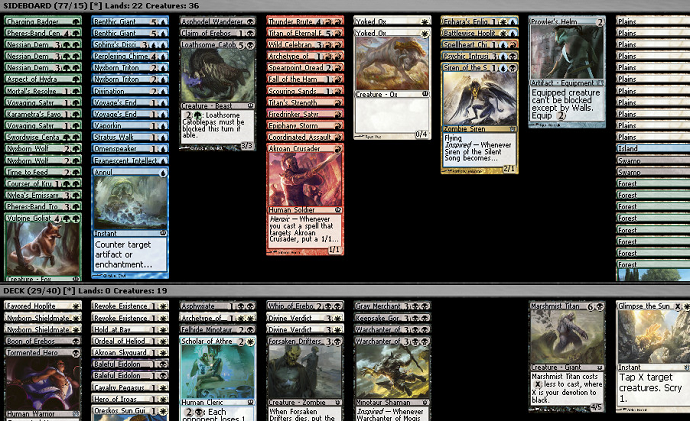
29 cards means we get to cut four or five depending, but the cuts aren’t hard unfortunately.

I cut Boon of Erebos, Hold at Bay, Felhide Minotaur, Forsaken Drifters, and two Warchanter of Mogis. The remaining deck is smooth and plays a lot of great cards (Gorgon, Whip, and Merchant to complement our already strong white), but it does play both Revoke Existence and doesn’t have a great sideboard.
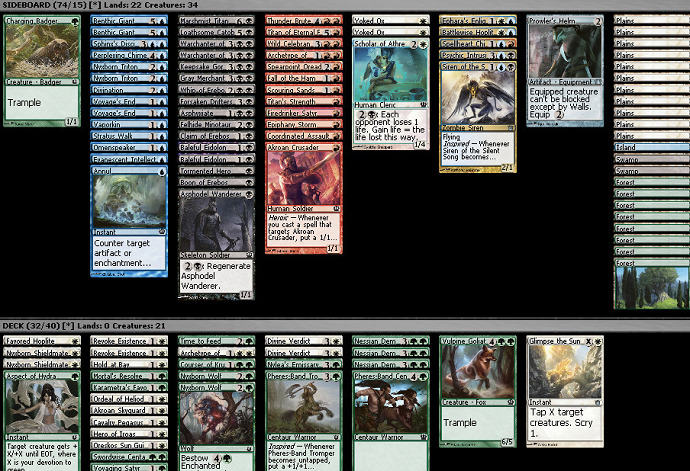
Looking at W/G, we get a pretty great-looking aggro deck that’s a little short on removal but has a nice curve and two copies of Divine Verdict to go over the top of big blockers.
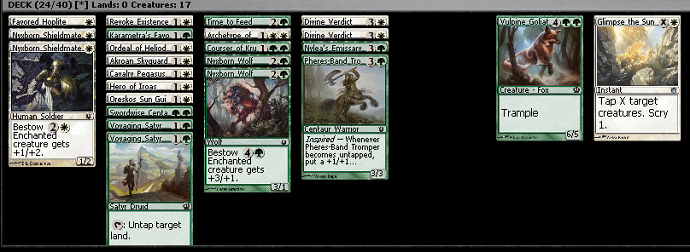
To get from 32 to 24, I cut three Nessian Demolok, one Revoke Existence, Hold at Bay, Pheres-Band Centaurs, Aspect of the Hydra, and Mortal’s Resolve, which gives you some idea of how sideboarding might look during the tournament.
The reason I like the W/G deck a little more is because of its aggressive nature. I don’t necessarily think either deck is really good enough to 9-0 a day 1 of a GP, but there is no reason to splash in either deck so they’re at a weird threshold. I think the W/G deck is more synergistic and will simply get better draws on average, which is really what you need to think about once you’ve decided on a couple of color combinations to choose between. I also really like Nyxborn Wolf in this Limited format, and this deck gets to play two.
In the end, Grand Prix tournaments are meant to be fun, and while it’s nice to win, I advise anyone going to Philly to be familiar with all the cards (reading this article is a great start) and to actually go through the motions of analyzing a few sealed pools with friends if you can. I’ve practiced with about twelve pools at this point, and I have a pretty good feel for how the decks look and am hoping the knowledge and lessons I’ve learned both online and in real life will carry me into day 2, where I can exercise my BTT Draft experience.
How do you guys feel about this Sealed format? With Grand Prix Philadelphia right around the corner, I’d love to discuss these sealed pools and any others you may have to prepare for the tournament. Hopefully I’ll see ya there!
